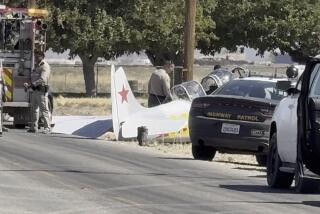2nd B-1 Crash in 2 Weeks Prompts Air Force Probe
- Share via
WASHINGTON — An Air Force team on Friday began investigating the second crash of a B-1 bomber in less than two weeks, an accident involving an Air Force B-1B bomber as it attempted to land at Ellsworth Air Force Base in South Dakota.
The crash, in which the crew of four escaped with minor injuries, occurred late Thursday as most of the B-1 fleet was being returned to flight lines after safety inspections instigated because of a B-1 crash on Nov. 8 near Dyess Air Force Base in Abilene, Tex.
Air Force officials said there was no indication of a fire on board before the accident, but that the $280-million craft burst into flames after impact. Air Force officials said they do not know what caused the accident, but suspicions appear to focus on the possibility that the plane hit a power line near Ellsworth’s landing field, causing it to veer out of control.
The crash brings to three the number of B-1Bs destroyed during the aircraft’s troubled deployment, which began in November, 1986. An early version of the plane also crashed in August, 1984, killing one man and injuring two.
In Washington, a White House spokesman said that President Reagan was briefed on the latest B-1 mishap, but he said the Administration is not concerned about the status of the B-1 program.
“If you look back on the record of other aircraft that have been introduced, you’ll find there are problems at the beginning with various aspects of the craft. The record on the B-1B is actually better than it has been with other aircraft that have been introduced,” White House spokesman B. Jay Cooper told reporters.
Brig. Gen. Robert Marquette, commander of the 12th Air Division based at Ellsworth, told reporters that the plane apparently hit power lines and crashed short of the runway while descending to land at the base five miles northeast of Rapid City. He said that initial evidence indicated there was no engine fire, the apparent cause of the bomber crash last week in Texas.
“Weather was a factor. Visibility was reduced,” Marquette added. Fog blanketed the area at the time of the 10:40 p.m. crash and snow Friday hampered investigation of the wreckage.
The plane was one of 34 B-1Bs stationed at Ellsworth that had been returned to service last weekend following a round of safety inspections. The Air Force ordered the inspections of the entire 98-plane force in the wake of the Texas crash.
Capt. Harry G. Evans, a Strategic Air Command spokesman, said Friday that 65 of the 98 B-1 warplanes had been returned to service after a three-hour inspection of electrical systems, hydraulic lines and fuel lines.
More to Read
Sign up for Essential California
The most important California stories and recommendations in your inbox every morning.
You may occasionally receive promotional content from the Los Angeles Times.











